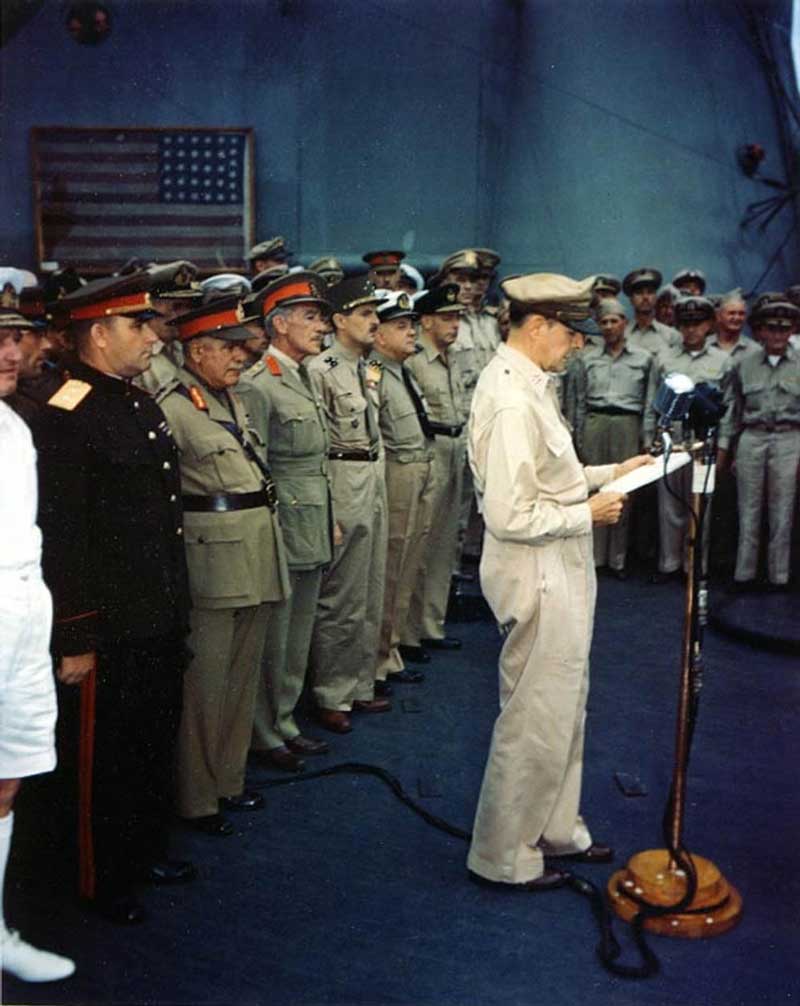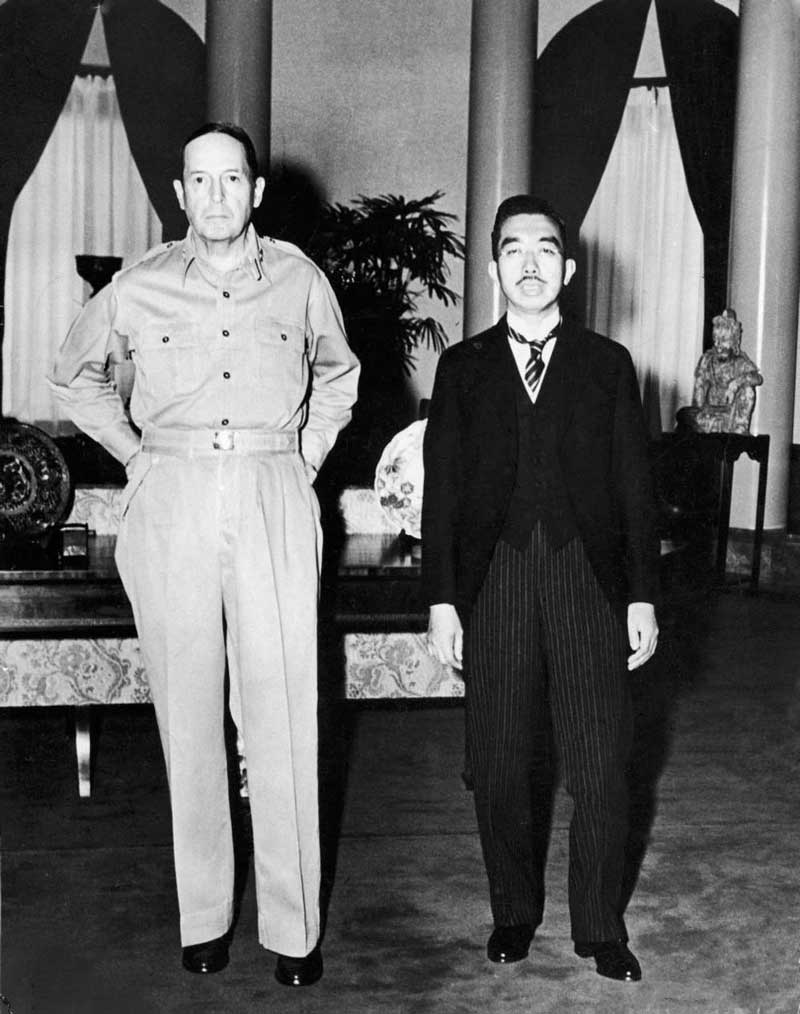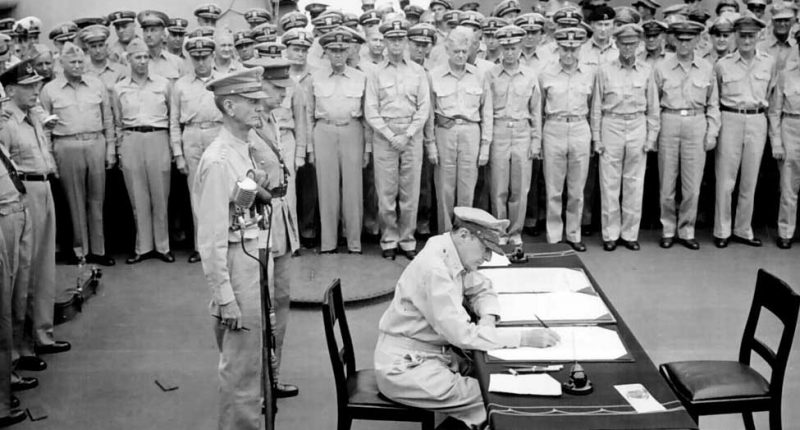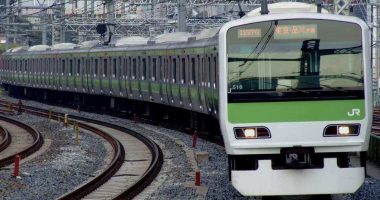General Douglas MacArthur, who had been commander of the United States Army Forces in the Far East, landed at Atsugi in Kanagawa Prefecture on 30 August, 1945. As Supreme Commander for the Allied Powers (SCAP) he was responsible for steering a war-ravaged Japan on a course to recovery.
The Instrument of Surrender was signed on 2 September, 1945, aboard the USS Missouri. The same flag that had flown on Commodore Perry’s ship in 1853 was borrowed from the U.S. Naval Academy Museum for the occasion, a symbol made all the more poignant by the fact that MacArthur was a blood-relative of Perry.

SCAP (the designation was also used to refer to the allied offices more generally) had much work to do. First the military, so intertwined as it was with Japanese politics, needed to be disbanded and a secular and representative government established in its place (which would, for the duration of the occupation, be under the considerable influence of SCAP and its policies). Then there was the issue of punishing those responsible.
Shortly after arriving, MacArthur had ordered the arrest of suspected war criminals, Japan’s wartime prime minister and former general of the Imperial Japanese Army, Tojo Hideki, among them (he shot himself in the stomach when forces came for him only to be resuscitated by U.S. doctors). Conspicuously, Emperor Hirohito was not. While there were voices calling for the emperor, too, to be tried, MacArthur was of the resolve that, as the representative of the Japanese people, directly instigating him as a player in Japan’s aggression would make the occupation and goal of rebuilding impossible. Instead Hirohito was used to give legitimacy to reforms, and SCAP went to great lengths to ensure that any incriminating evidence against the emperor did not surface publicly.
MacArthur’s decision still reverberates today, especially in Japan’s relationship with its Asian neighbors. There is a credible argument that it created a moral divide between the Japanese people and the army such that rhetoric today sometimes revolves around how the military were responsible for the country’s aggression, indirectly lightening the burden of collective blame from the shoulders of the nation and its citizens.

Nevertheless, MacArthur did realize the importance of separating state and religion. As we have seen, the notion that the emperor was a direct descendant of the sun goddess Amaterasu is one that has roots in very early Japanese history, and much of the wartime propaganda rested on the notion of divine racial purity. In an imperial rescript issued in a New Year’s statement on 1 January, 1946, the Imperial Family declared that the “ties between Us and Our People… are not predicated on the false conception that the Emperor is divine…”. The new constitution enacted in 1947—perhaps the most remarkable achievement of the occupation—went further in delimiting his role, stating the emperor to be “the symbol of the State and of the unity of the People, deriving his position from the will of the people with whom resides sovereign power”.
This 1947 constitution also outlawed the use of war to settle international disputes in Article 9, the wording of which is still debated today as the more conservative side of Japan’s polity seeks ways for the country to play bigger roles abroad militarily.
Article 9. Aspiring sincerely to an international peace based on justice and order, the Japanese people forever renounce war as a sovereign right of the nation and the threat or use of force as means of settling international disputes… [L]and, sea, and air forces, as well as other war potential, will never be maintained. The right of belligerency of the state will not be recognized.
By 1952 when the American occupation came to an end, Japan had seen reforms to its political structure, new land and labor acts, changes to its education system, and the enfranchisement of women. The country was ready to chart its recovery.
That Japan rose from the ashes of war to become a global economic superpower must be one of the most phenomenal stories in twentieth century history. While the spirit and determination of the Japanese people cannot be understated, other factors were highly conducive to the country’s “miraculous” rise: the currency was fixed at ¥360 to the U.S. dollar from 1949 until 1971, providing a huge boost for exporters; U.S. military presence in the country—especially with the onset of the Cold War—meant that Japan’s own military spend was comparatively small; and Japan was behind by Western standards and so, for the early years at least, superior technology could simply be imported and duplicated.
But, as much as these each provided catalysts for growth, the economic leaps and bounds made in the 1960s, 70s, and 80s can only be explained by more fundamental factors: a highly-educated workforce coupled with a government focused on economic goals and fully supportive of the Japanese conglomerates. Moreover, at the heart of the zaibatsu—a loose term for the interlinked mega corporations of which Mitsubishi, Mitsui, and Sumitomo are the most famous—were the sarariiman: employees known for their long hours and unfaltering loyalty to their company. Statistics show that throughout the post-war era Japanese workers put in 10-20% more hours per year than their counterparts in the West.

Japan Inc. was massively successful at assimilating foreign technology, improving it, and selling products ranging from Walkmans to cars to the outside world at a margin made healthier by Japan’s famed efficiency in the manufacturing process. The excess liquidity produced by this export-driven economic model, coupled with a consumer culture of saving, led to lax lending by the banks, made worse by the tightly-knit relationship and mutual stock ownership practices companies had with one another. Between 1985 and 1989 the stock market tripled in value. Cheap money drove confidence and speculative investment in stocks and real estate, leading to spurious claims such as the value of the ground of the Imperial Palace being worth more than the state of California.
The Nikkei 225 stock market index peaked at 38,957 on 29 December, 1989. Within a year it would lose almost half its value as the bubble burst and investors were faced with reality. The 1990s are referred to as the “Lost Decade”—real wages fell along with GDP and the country battled with deflation. The crash didn’t just impact investors and the banks: the bursting of the real estate bubble left many ordinary Japanese deep in negative equity.
The legacy of the bubble of the 1980s still impacts economic policy today. To try and reflate the economy and stimulate growth the Japanese government has increased borrowing and run a deficit since 1991. As of 2016, Japan’s total (gross) debt stands at just over one quadrillion yen (about $9 trillion) or around 230% of GDP.
But it would be wrong to chart Japan’s course during the latter half of the 20th century in purely economic terms: culture has undergone equally huge transformations, starting with the impact the U.S. occupation had on the country. From the dance halls of Roppongi to Hollywood movies and hamburgers, Western—or, more specifically, American—culture offered something different for the youth during the post-war years. Many aspects of society underwent change. For instance, before the war most marriages were through o-miai (“exchanging looks”), introductions one step short of arranged marriage but where wedlock is on the table from the start. However, with Western culture came Western ideals and the idea of renai-kekkon (“love marriage”) took hold in the hearts of the baby boomers such that today o-miai marriages account for less than a few percent of the total.
Nor was this entirely a one-way street. From cinema to manga and anime, Japan exported its own homegrown culture, too. And to the extent that color televisions and the miniaturization of consumer electronics have been a cultural change as much as a technological one, Japan’s influence on the outside world in the latter half of the 20th century is by no means insignificant.
Societal changes have also been seismic in nature. Firstly, working style is shifting. The culture of a “job for life” at the same company is eroding as the next generation finds little appeal in the stereotypical sarariiman lifestyle (long hours, rigidly hierarchical work environment, predictable career path). This has led to the rise of the furiita (“fleeter”), temporary staff who hop from job to job, attracted by the flexibility of the system (as are the companies who employ them, which benefit from the ability to expand and contract their workforce more easily in line with economic prospects). Today almost 40% of those in employment are classed as temporary workers.
Secondly, gender inequality has been rebalanced. From its Confucian-inspired beginnings Japan has always been a patriarchal society. The stereotypical pre-war household had the man as the breadwinner whose word was final and the woman confined indoors playing housewife. But gradually women began to enter the workplace and by the late 1960s the term “office lady” had entered the Japanese lexicon. Unlike the sarariiman, however, who could at least hope for predictable progression up the career ladder, office ladies, nicknamed shokuba no hana (“office flowers”), were employed in administrative roles on the basis that at some point they would settle down and become good housewives as tradition dictated. This, too, would change.
In 1960 less than 3% of women graduating from compulsory education went on to study at university. By 1980 this had risen to 12% and today the figure stands at just under half, and females compete more equally with their male counterparts in the annual battle for positions at the top employers.
Despite this progress, however, some women still feel that they must choose between career or family. Many choose the former and this is a contributory factor to Japan’s low fertility rate which, if unchanged, is predicted to result in a natural population decline from 127 million today to 80 million by 2065. Other factors include a poor work-life balance, small living spaces, and fewer and later marriages. This is compounded by Japan having the longest life expectancy in the world and, based on current trends, projections show that 40% of the population will be over 65-years-old by 2065. These figures present Japan with what may well be its greatest challenge in the 21st century.
Further exacerbating this problem of a declining population is a general skepticism towards immigration, a mindset that is at least partially rooted in the country’s isolationist past. As of 2016, just 3.3% of the population of Tokyo Metropolis is non-Japanese. Remove Chinese and Korean nationals and this figure drops to just 1.3%. Foreigners from Southeast Asia, which one could argue is an important labor market for Japan, represent just 0.5% of the population.
But efforts are being made to make Japan—and Tokyo in particular—a more international place, the Tokyo 2020 Summer Olympics being a major catalyst. Significant initiatives include the 2011 change to the education system whereby English classes were made mandatory from fifth grade (10 years of age) onwards and policy changes to make it easier for skilled workers to obtain work visas (and for longer).
This country is by no means without challenges in the 21st century. But no matter how great these may appear, no nation has shown itself more resilient in the face of change than Japan.
- Previous: The Meiji Restoration & Imperial Japan


